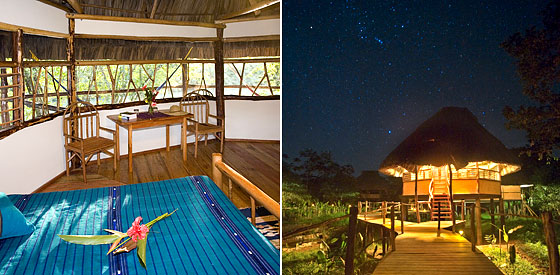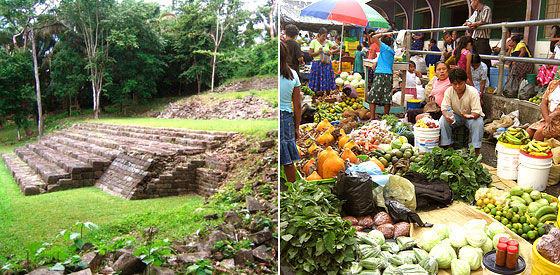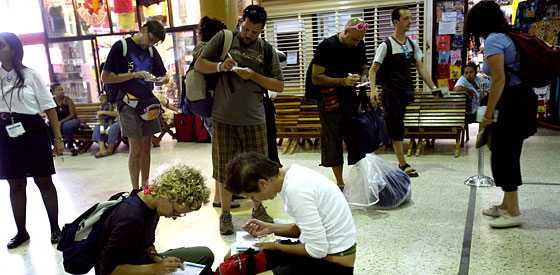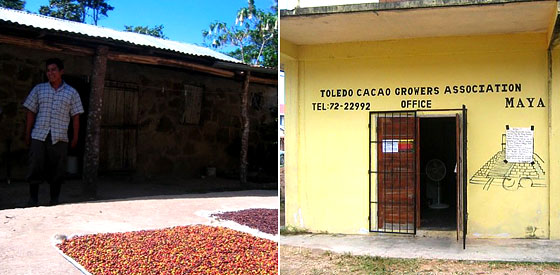1. Where to Stay

Along the sun-dappled banks of the Moho River, the Cotton Tree Lodge (cabanas from $139) is choco central for cacao lovers. The property produces its own brand of chocolate and is equipped with solar-powered conching machines (cocoa mixers).
Find sanctuary only fifteen minutes from downtown Punta Gorda at Hickatee Cottages (from $55). Cool off on the wild-plum-tree-shaded verandah or in the plunge pool, and be on the lookout for howler monkeys, Rufus-tailed hummingbirds, jaguars, free bike rentals, Wi-Fi, and home-baked bread.
The dozen cabanas at Machaca Hill Rainforest Lodge (rooms from $267) reopened this month in an 11,000-acre private reserve and Valencia-orange orchard—ideal for toucan spotting. Explore the Mayan (Mopan and Kek’chi-speaking) villages and cacao farms scattered throughout the Toledo District and delivers National Geographic–like views of the jungle-choked hills of Guatemala and Honduras in the distance.
2. Where to Eat

Belize’s coast is home to a large Garufina culture (descendants of West African slaves shipwrecked in 1565), but the food represents a mix of African, East Indian, Chinese, and British influences. Eat whole fried snapper, snook fillets, and juicy pork chops while lounging around Emery’s (702-2929; $3 to $10) screened-in patio, under a Caribbean-style thatched roof.
Look for the Marian’s Bayview sign just above the Titanic Bar and behind the market. (722-0129; $4 to $11). On a third-floor, open-air terrace, you’ll eat cahume cabbage and iguana as well as a variety of East Indian curries, all of which should be washed down with one of Belize’s two favored beers, Belikin lager or stout.
Spend the day touring a cacao farm and you’ll be rewarded with a humble but homemade lunch of caldo (spicy chicken soup), warm handmade corn tortillas, and kaku (cocoa drink) in a farmer’s home. Tours ($51 for three-hour tour, lunch is $6) are hosted by Mayan cacao growers Cyrila and Juan Cho (501-666-3444, juan@theorganicchocolatemaster.com), who sell their beans to the prestigious (and fair-trade) Green & Black’s chocolate.
3. What to Do

Visit the Mayan ruins of the mystical city of Lubaantun, considered by many to be the botanical epicenter of cacao. Walk through eighteen intricate plazas and three ball courts—once home to 20,000 Mayans.Look for the ticket attendant with an impressive collection of relics
No trip to Belize would be complete without a dip into its diver-beloved waters. Contact Roberto and April Echeverria at Wild Encounters (501/722-2716), P.G.’s only dive operators, for day trips to the Sapodilla Cayes Marine Reserve to see Belize’s prized barrier reef.
Visit the wild-coriander-scented market on Front Street (between Prince and Queen) on Wednesday or Saturday, its busiest times. Fuel yourself with a hot cheese- or butter-slabbed Johnnycake (fried pancake) and bargain for embroidered handkerchiefs and messenger bags made from recycled cacao bean harvest sacks.
4. Insider’s Tip

Phillip SW Goldson International Airport has one of the cheapest duty-free shops you’ll ever encounter. High-end rums go for $10 a bottle, top-shelf Scotches and liquors sell for as low as $15, and cartons of cigarettes cost a mere $10.
5. Oddball Day

Head to the Toledo Cacao Grower’s Association (TCGA) on Main Street in the early morning to catch a glimpse of the cacao farmers selling their beans at fair-trade prices. If you’re lucky, you’ll catch Mr. Buns pedaling around on his bike selling hot, homemade cinnamon and cheese buns. As the coastline steams up, cool off with a drive up into the mountains to find the stalwart German-speaking Mennonite farmers—just off the road to San Miguel—who fled here from Mexico in the fifties and who continue to produce and sell dairy, including a particularly creamy yogurt that’s an ideal accompaniment to spicy dishes. Continue on the gravel roads to Rio Blanco National Park, where a cascading twenty-foot waterfall drops into a deep pool (local legend says it’s bottomless) filled with crystal-clear water, where tourists and locals converge for refreshing swims. Several nature trails surround the waterfalls. The more adventurous will want to explore the cenote (underwater cave) at Blue Creek, which cuts 600 yards deep into the earth.
6. Links
The Belize Tourism page is a surprisingly helpful resource.
The Belize Times News is the region’s source of local news.
This beautiful and lush photo blog of Belize includes ruins, dive sites, harvesters and more.